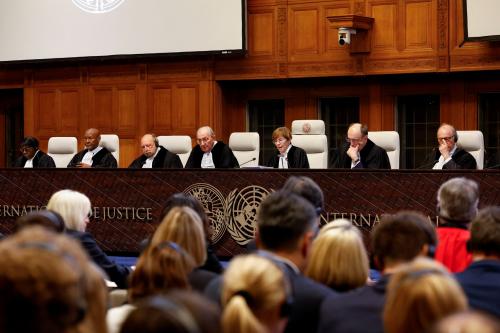Note: As new developments take place at Guantánamo and the detainee population continues to evolve, we will post occasional updates to this report.
View updates as of October 21, 2009 »
Introduction
The following report represents an effort both to document and to describe in as much detail as the public record will permit the current detainee population in American military custody at the Guantánamo Bay Naval Station in Cuba. Since the military brought the first detainees to Guantánamo in January 2002, the Pentagon has consistently refused to comprehensively identify those it holds. While it has, at various times, released information about individuals who have been detained at Guantánamo, it has always maintained ambiguity about the population of the facility at any given moment, declining even to specify precisely the number of detainees held at the base. In its most recent statements, for example, the military refers to the Guantánamo population as numbering “approximately 250.”[i] When the government repatriates detainees, it generally identifies the number of detainees transferred, but not their names.[ii]
The result is that despite a debate that has raged over American detention policy almost since the outset of the war on terrorism, the actual detainee population which the debate concerns remains strangely obscure. The current population numbers less than a third of the total number of detainees who have passed through the facility since 2002. And the composition of the population has changed markedly as it has declined. Yet precisely how it has changed remains fuzzy. Which detainees are still there and which have been sent home? What allegations does the military make against the residual population and how serious are they? How have the detainees responded to these allegations? Are they, as the Bush administration has described the Guantánamo population, the “worst of the worst”?[iii] Or are they composed, as the New York Times once put it, of “hundreds of innocent men . . . jailed at Guantánamo without charges or rudimentary rights”?[iv] Or do they, perhaps, vary? Much commentary on the merits of the American detention policy relates to a detainee population composed chiefly of people no longer at the base, as do a number of frequently-cited academic studies.[v]
Though one of the present authors has written broadly on detainee policy, our purpose in these pages is not to advocate any particular policy with respect to habeas corpus, closing Guantánamo, or detainee affairs more generally. Nor is it to take a position regarding whether the government is properly holding the Guantánamo detainees as enemy combatants—either individually or as a group. It is, rather, to identify and describe empirically who is at Guantánamo today, what the government alleges about them, and what they claim about their own affiliations and conduct.
The report proceeds as follows: In the following section, we briefly recount the history of the government’s document releases concerning the detainee population at Guantánamo. We then offer an overview of the demographics of the current population, based on our examination of these releases, and describe and analyze government allegations against the detainees who remain at Guantánamo. In the next section, we report and categorize the statements by the detainees themselves in the review procedures the military set up to evaluate their cases. In the penultimate section, we offer some concluding observations. Finally, we describe the sources and methods we used to identify the current population of the facility, and those transferred or released.
[i] The military disclosed this figure in a press release announcing the transfer of three Algerian detainees to Bosnia on December 16, 2008. This release is available at http://www.defenselink.mil/Releases/Release.aspx?ReleaseID=12394.
[ii] See “Detainee Transfer Announced,” November 10, 2008, available at http://www.defenselink.mil/releases/release.aspx?releaseid=12342, for a typical Pentagon press release announcing detainee transfers. Note that the two detainees transferred to Algeria are not identified by name.
[iii] See former presidential spokesman Ari Fleischer’s press briefing on January 23, 2002, available at http://www.whitehouse.gov/news/releases/2002/01/20020123-18.html.
[iv] Editorial, “The Real Agenda,” The New York Times, July 16, 2006, Section 4, 11.
[v] Two examples of such academic studies are Mark and Joshua Denbeaux’s “Report on Guantánamo Detainees: A Profile of 517 Detainees Through Analysis of Department of Defense Data,” February 8, 2006, available at http://law.shu.edu/news/guantanamo_report_final_2_08_06.pdf (hereafter the “Seton Hall study”), and Joseph Felter and Jarret Brachman’s “CTC Report: An Assessment of 516 Combatant Status Review Tribunal (CSRT) Unclassified Summaries,” July 25, 2007, available at http://www.ctc.usma.edu/csrt/CTC-CSRT-Report-072407.pdf.
The Brookings Institution is committed to quality, independence, and impact.
We are supported by a diverse array of funders. In line with our values and policies, each Brookings publication represents the sole views of its author(s).



